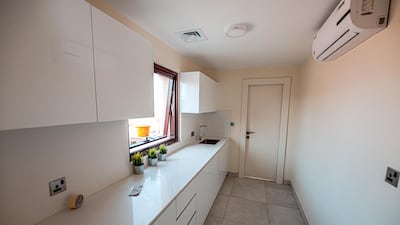A 3D-printed villa made in Sharjah is not only environmentally friendly but also substantially reduces construction costs, a new study shows.
The "green" house grabbed global attention at the end of last year when it became the Middle East’s first fully functioning 3D-printed villa.
Engineers in Sharjah 3D-printed a house with the help of a Dh1 million robot in December 2020.
Made of sustainable eco-friendly cement, it was built in almost two weeks.
Now, a study in the journal Sustainability has shown that the way it was constructed not only saved time but also offered environmental benefits.
American University of Sharjah
American University of Sharjah and University of Sharjah scientists found that constructing the 3D-printed house created little more than half the carbon emissions from building a conventional one.
There were advantages in many other environmental parameters, including the amount of particulate matter formed during construction and how much water was used.
Particulate matter of different sizes is mainly responsible for pollution on construction sites.
“The key reason [for the improved performance] is the overall efficiency, such as eliminating or reducing material wastage during the construction phase,” said Dr Kazi Fattah, an associate professor at AUS and a co-author of the new study.
The study found that building the villa using 3D printing produced the equivalent of 608.55 kilograms of carbon dioxide, compared with 1,154.2kg with conventional methods.
Water consumption using 3D printing was 183.95 cubic metres, compared with 233.35 cubic metres with standard techniques.
It also has lower thermal heat conduction, which means it will be cooler and so will use less energy to lower the internal temperature.
Dr Fattah said the findings of the study tied in with previous research, which has also shown that 3D-printed buildings are typically more environmentally friendly than ones that are conventionally constructed.
Part of the reason is that 3D printing can make construction simpler by reducing the need for, as an example, the placement and removal of formwork, which are moulds into which concrete is poured.
“3D printing makes it easy to use prefabricated sections as well; this can reduce manufacturing losses and transportation needs,” Dr Fattah said.
Hadeer Abdalla and Prof Adil Tamimi of AUS, and Dr Mohamed Abdallah of the University of Sharjah were the co-authors of the study.
The 3D-printed villa was produced using technology from a Dutch company, CyBe, whose machinery can “print” concrete at 60 centimetres per second. AUS and research institutions in Finland and the Netherlands were also involved.
Theo Salet, a professor of structural design/concrete structures at Eindhoven University of Technology in the Netherlands, who was not an author of the new study, indicated that 3D printing could help to promote more “circular” concrete, meaning that the material can be reused.
“3D printing offers new degrees of freedom in design and this freedom can and must be used to create circular designs,” Prof Salet said.
“This could be the reuse of components or the ability to crush components and reuse all fractions in new printable concretes. This is ongoing research, but promising.”
As concern over waste increases, authorities are trying to make economies more circular, with the European Union, for example, having set a target of 2050 to achieve this inside the bloc.
It will also lead to lower construction costs, which is especially important in countries with a shortage of affordable homes.
“It can increase construction productivity and overcome a lack of construction workers,” Prof Salet said. “History tells us that scaling from a low tech to a high-tech industry makes things cheaper and that is an important driver as well for 3D printing.”
While not yet in widespread use, 3D printing is likely to become more common as the technology advances.
Areas of improvement are possible. For example, current technology does not allow for the construction of high-rise buildings, Dr Fattah said. Until now, 3D printing has primarily been used to build low-rise buildings or decorative sections.
“However, given the research work being carried out in this field and the interest, it is likely that the technology will see more use,” he said.





